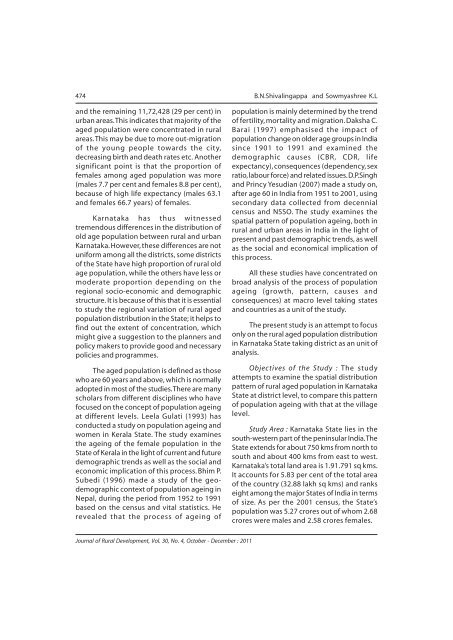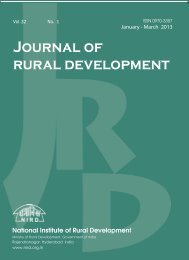Issue for October - December 2011 - National Institute of Rural ...
Issue for October - December 2011 - National Institute of Rural ...
Issue for October - December 2011 - National Institute of Rural ...
You also want an ePaper? Increase the reach of your titles
YUMPU automatically turns print PDFs into web optimized ePapers that Google loves.
474 B.N.Shivalingappa and Sowmyashree K.Land the remaining 11,72,428 (29 per cent) inurban areas. This indicates that majority <strong>of</strong> theaged population were concentrated in ruralareas. This may be due to more out-migration<strong>of</strong> the young people towards the city,decreasing birth and death rates etc. Anothersignificant point is that the proportion <strong>of</strong>females among aged population was more(males 7.7 per cent and females 8.8 per cent),because <strong>of</strong> high life expectancy (males 63.1and females 66.7 years) <strong>of</strong> females.Karnataka has thus witnessedtremendous differences in the distribution <strong>of</strong>old age population between rural and urbanKarnataka. However, these differences are notuni<strong>for</strong>m among all the districts, some districts<strong>of</strong> the State have high proportion <strong>of</strong> rural oldage population, while the others have less ormoderate proportion depending on theregional socio-economic and demographicstructure. It is because <strong>of</strong> this that it is essentialto study the regional variation <strong>of</strong> rural agedpopulation distribution in the State; it helps t<strong>of</strong>ind out the extent <strong>of</strong> concentration, whichmight give a suggestion to the planners andpolicy makers to provide good and necessarypolicies and programmes.The aged population is defined as thosewho are 60 years and above, which is normallyadopted in most <strong>of</strong> the studies. There are manyscholars from different disciplines who havefocused on the concept <strong>of</strong> population ageingat different levels. Leela Gulati (1993) hasconducted a study on population ageing andwomen in Kerala State. The study examinesthe ageing <strong>of</strong> the female population in theState <strong>of</strong> Kerala in the light <strong>of</strong> current and futuredemographic trends as well as the social andeconomic implication <strong>of</strong> this process. Bhim P.Subedi (1996) made a study <strong>of</strong> the geodemographiccontext <strong>of</strong> population ageing inNepal, during the period from 1952 to 1991based on the census and vital statistics. Herevealed that the process <strong>of</strong> ageing <strong>of</strong>population is mainly determined by the trend<strong>of</strong> fertility, mortality and migration. Daksha C.Barai (1997) emphasised the impact <strong>of</strong>population change on older age groups in Indiasince 1901 to 1991 and examined thedemographic causes (CBR, CDR, lifeexpectancy), consequences (dependency, sexratio, labour <strong>for</strong>ce) and related issues. D.P.Singhand Princy Yesudian (2007) made a study on,after age 60 in India from 1951 to 2001, usingsecondary data collected from decennialcensus and NSSO. The study examines thespatial pattern <strong>of</strong> population ageing, both inrural and urban areas in India in the light <strong>of</strong>present and past demographic trends, as wellas the social and economical implication <strong>of</strong>this process.All these studies have concentrated onbroad analysis <strong>of</strong> the process <strong>of</strong> populationageing (growth, pattern, causes andconsequences) at macro level taking statesand countries as a unit <strong>of</strong> the study.The present study is an attempt to focusonly on the rural aged population distributionin Karnataka State taking district as an unit <strong>of</strong>analysis.Objectives <strong>of</strong> the Study : The studyattempts to examine the spatial distributionpattern <strong>of</strong> rural aged population in KarnatakaState at district level, to compare this pattern<strong>of</strong> population ageing with that at the villagelevel.Study Area : Karnataka State lies in thesouth-western part <strong>of</strong> the peninsular India. TheState extends <strong>for</strong> about 750 kms from north tosouth and about 400 kms from east to west.Karnataka’s total land area is 1.91.791 sq kms.It accounts <strong>for</strong> 5.83 per cent <strong>of</strong> the total area<strong>of</strong> the country (32.88 lakh sq kms) and rankseight among the major States <strong>of</strong> India in terms<strong>of</strong> size. As per the 2001 census, the State’spopulation was 5.27 crores out <strong>of</strong> whom 2.68crores were males and 2.58 crores females.Journal <strong>of</strong> <strong>Rural</strong> Development, Vol. 30, No. 4, <strong>October</strong> - <strong>December</strong> : <strong>2011</strong>
















